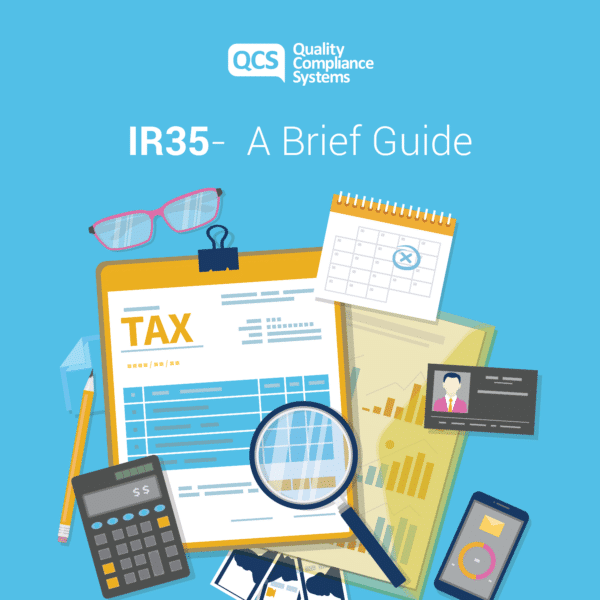The off-payroll working rules, also known as IR35, are a set of tax laws which can apply where businesses engage workers through an intermediary (usually a personal service company (PSC), but this could also be a partnership or an individual).
IR35 ensures that individuals who would have been employees if they were providing their services directly to an end client, rather than via a PSC, pay broadly the same income tax and national insurance contributions as employees.
Many businesses engage contractors through a PSC to provide greater flexibility to their business, for example, to deal with fluctuating demands in labour. By engaging workers through PSCs, businesses can also make significant costs savings, because contractors engaged in this way are not entitled to any employment rights (such as holiday pay, sick pay or redundancy pay). Businesses who contract workers via PSCs do not have to make PAYE deductions, or pay employer’s national insurance contributions (NICs) on the workers’ earnings either.
Provided that contractors engaged via PSCs display the true characteristics of self-employed status, there is nothing wrong with this type of working arrangement. However, where a contractor appears to be an employee (see below) and they are using the PSC as a means of disguising their true employment status, the IR35 rules are likely to apply. PAYE deductions must then be made from the contractor’s earnings and paid to HMRC, together with employer’s NICs.
Who do the rules apply to?
The IR35 rules may affect:
- A contractor/worker who provides their services through a PSC
- A business who receives services from a contractor through a PSC; or
- An agency providing contractors/workers’ services through a PSC
In the private sector, the new rules set out below will apply only to large and medium businesses. Those businesses will become responsible for assessing an individual’s employment status. However, small businesses will be exempt from this reform.
A “small business” will be defined by the Companies Act 2006. This is broadly a business that has two or more of the following features:
- An annual turnover £10.2m or less
- A balance sheet of £5.1m or less; and/ or
- 50 employees or less
What is changing?
Changes to IR35 in the private sector are due to come into effect for medium and large organisations (as defined in the Companies Act 2006) on 6 April 2021. Public sector changes have already taken place.
Until that date, it is a contractor/PSC’s responsibility to decide the contractor’s employment status and deduct tax and NICs in the event that the IR35 rules apply.
With effect from 6 April 2021, the responsibility for determining a contractor’s employment status will shift to end clients (i.e. the businesses who benefit from contractors’ services). Where an end client concludes that the IR35 rules apply, the fee payer (i.e. the organisation paying the PSC for the contractor’s services – this could be the end client or an agency, depending on the circumstances) becomes responsible for accounting for and paying the related tax and NICs, including employer’s NICs, to HMRC. Therefore, it is important that employers understand the true employment status of the workers they engage.
Determining whether a worker is actually an employee
There is no precise legal test to determine whether a worker is in fact an employee and generally, no single factor which will determine employment status. However, HMRC has produced guidance on factors it considers to be most important in determining an individual’s employment status.
It has also produced an online tool which can assist end users in determining employment status for tax purposes, known as the CEST (Check Employment Status for Tax) Tool.
What are the factors HMRC will consider?
- Personal service – if the worker is entitled to provide a substitute to do the work, this may point away from an employment relationship. However, the absence of a right of substitution will not necessarily make the situation one of employment
- Mutuality of obligation – in an employment relationship there must be an obligation on the part of the worker/individual to provide his or her work or skill and an obligation on the part of the engager to pay the for that service. Where there is no mutuality of obligation, this may point more towards self-employed status
- Right of control – in an employment relationship, the employee must be subject to a certain degree of control, for example, an employee will usually be expected to work set hours each day or week. An independent contractor is more likely to have the freedom to work when and where they want. The fact that a worker may be told how to perform duties will usually be seen as a strong indicator of employment but, where the worker is an expert, the absence of this aspect of control would probably not be seen as that significant
- Right of substitution and engagement of helpers – if a worker has a right to send a replacement or engage a helper, and particularly if the worker has to pay any replacement or assistant, this would be an indicator of self-employed status (note however, that this has to be a genuine right/possibility and not simply something that is contained within terms and conditions)
- Provision of own equipment – an independent contractor would generally provide whatever equipment is needed to do the job. In contrast, where a worker is provided with the necessary equipment and materials, that would point to employment
- Financial risk – individuals who risk their own money (for example, incurring significant amounts of expenditure on training in order to obtain skills needed to fulfil a contract, or making an initial outlay for materials) are less likely to be employees. Self-employed individuals may also be required to rectify unsatisfactory work in their own time for no additional reward.
Financial risk could also take the form of quoting a fixed price for a job, with the consequent risk of bearing the additional costs if the job overruns. The risk of making a loss is a very strong indicator of self-employed status and can be decisive on its own
- Opportunity to profit – a person whose profit (or loss) depends on the capacity to reduce overheads and organise work effectively is more likely to be an independent contractor. People who are paid by the job (rather than on an hourly or day rate, for example) will often be in this position
- Length of engagement – the length of an engagement is unlikely to be determinative in itself with regard to an individual’s employment status. However, it should be noted that it is more likely that an employee will have an open-ended contract
- Part and parcel of the organisation – if an individual is “part and parcel” of a business’s organisation, they are more likely to be an employee. The HMRC guidance gives the example of someone taken on to manage a business’s staff, who would normally be seen as an integral part of the business’s organisation with the result that this would be seen as a strong indicator of employment
- Employee-type benefit – if an individual is entitled to benefits such as paid leave, membership of a firm’s pension scheme, right to car park space and canteen facilities, this will be a good indicator that an employment relationship exists. A contract of employment may also contain access to a grievance procedure and the individual may be subject to disciplinary procedures. However, the absence of such benefits will not be determinative
- Right to terminate contract – a right to terminate an engagement for a reason other than serious breach, by giving notice of a specified length, may be viewed as indicative of a contract of employment. However, this would (in the view of HMRC) only be a minor factor
- Personal factors – the HMRC guidance also indicates that it may sometimes be necessary to take into account factors which are personal to the individual. The guidance gives the example of a skilled individual who works for a number of clients throughout the year and has a business-like approach to obtaining engagements. It says that this will point towards self-employment. However, the guidance also states that personal factors will usually carry less weight in the case of an unskilled individual
- Mutual intention – the intention of both parties can be decisive where the factors pointing to employment and to an independent contractor are evenly balanced. However, a stated intention (for example, that an individual is not an employee) will not, without more, be determinative
Please note the above is not an exhaustive list.
What should businesses be doing now?
Given the potentially significant tax liabilities that the IR35 changes will create, it is important that businesses who engage contractors through PSCs (whether directly or via an agency) begin to prepare for these reforms by identifying their current engagements and determining each contractor’s true employment status. Going forward, prior to engaging a contractor through a PSC, businesses should carry out a detailed assessment to determine their employment status, taking into account the factors outlined above and making use of the CEST Tool where appropriate.
HMRC supporting guidance can be accessed for help using the CEST Tool. This guidance confirms that HMRC will stand by the result produced by the CEST Tool provided the information is accurate and it is used in accordance with their guidance. HMRC will not stand by the results achieved through contrived arrangements that have been deliberately created or designed to get a particular outcome. This would be considered deliberate non-compliance and the business would risk financial penalties.
It is also recommended that businesses review their internal systems such as payroll software, process maps and HR and on-boarding policies to ensure that any changes required in light of IR35 are put in place.
Specialist tax advice should also be obtained to understand the implications of IR35 on each business ahead of the changes coming into effect.
Should you have any questions in relation to IR35, please do not hesitate to contact a member of Napthens’ Employment team.




